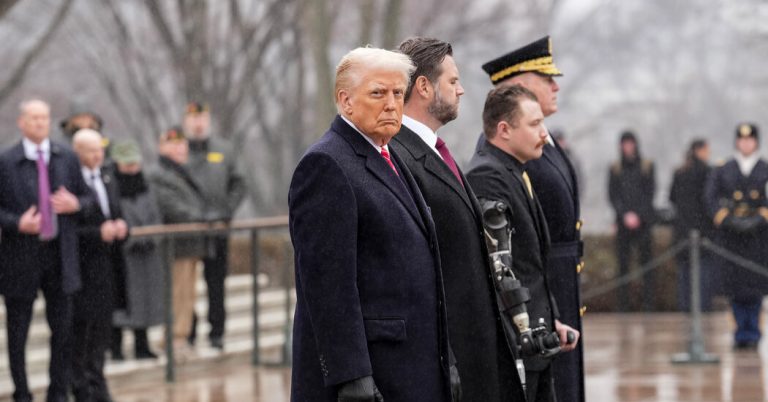President Trump signed an executive order on Monday to delay the enforcement of the federal ban on TikTok for 75 days, even though the law took effect on Sunday and it is unclear whether such a move could circumvent it.
The order, one of the first acts of Mr. Trump after taking office directs attorney general to take no enforcement action so his administration has “an opportunity to determine an appropriate course forward”.”
While signing the order, Mr. Trump told reporters that “the US should be entitled to half of TikTok” if a deal is reached for the app, without elaborating. He said he believed TikTok could be worth a trillion dollars.
The order could immediately face legal challenges, including whether a president has the power to stop enforcement of a federal law. Companies subject to the law may decide that the mandate does not provide a shield against legal liability.
The federal law banning TikTok, which is owned by China’s ByteDance, required the app to be sold to a non-Chinese owner or it would be banned. The law allows a president to grant a 90-day extension if a buyer is found, but only if there is “substantial progress” on a deal that can be completed within that period. It is not clear that an extension is available given that the law is already in place.
Seeking to circumvent federal law, Mr. Trump has raised serious questions about the limits of presidential power and the rule of law in the United States. Some lawmakers and legal experts have raised concerns about the legality of an executive order, particularly after the Supreme Court’s ruling upholding the law on Friday and the national security concerns that prompted lawmakers to draft it in the first place.
Former President Joseph R. Biden Jr. had signed the law, which was overwhelmingly passed in Congress last year, forcing ByteDance to sell TikTok or face a ban. TikTok had faced security concerns that the Chinese government could use it to spread propaganda or collect data on US users. The law imposes financial penalties on app stores and cloud providers unless they stop working with the app.
TikTok was briefly killed for US users over the weekend, but returned on Sunday after Mr. Trump on social media that he was planning an executive order. While the app was working again for people who had already downloaded it, it disappeared from the Google and Apple stores on Saturday and remained unavailable on Monday.
The efforts of Mr. Trump to keep TikTok online has significant implications for its users. The app reshaped the social media landscape, defined popular culture, and created a livelihood for millions of influencers and small businesses based on the platform.
In the executive order, Mr. Trump said his constitutional responsibilities include national security. He says he wants to consult with advisers to look at the concerns TikTok is raising and the mitigation measures the company has already taken.
The administration will “pursue a resolution that protects national security while saving a platform used by 170 million Americans,” according to the order, which called the timing of the law “unfortunate.”
TikTok and Apple did not immediately respond to requests for comment. Google declined to comment.
TikTok’s ties to China have long raised national security concerns, including from Mr. Trump. Near the end of his first term in 2020, Mr. Trump issued an executive order that would have banned app stores from making TikTok available for download. He then pushed for an American company to buy the app, but those efforts failed when he lost his re-election bid.
Last year, the effort was revived by Congress and Mr. Biden signed it into law in April. The law targeted app stores, such as those run by Apple and Google, and cloud computing companies. He said those companies would not be able to distribute or host TikTok unless the app is sold to a non-Chinese owner by January 19.
Then Mr. Trump reversed positions. He joined the app in June and told TV in March that there are young people who would go “crazy” without TikTok.
“I guess I have a warm spot for TikTok that I didn’t have initially,” said Mr. Trump signing executive orders Monday afternoon.
TikTok challenged the law in federal court, saying it interfered with its users’ free speech rights, as well as the company’s own First Amendment rights. The Court of Appeals for the D.C. Circuit upheld the law in December. TikTok appealed to the Supreme Court, which on Friday also upheld the law.
TikTok and some Democrats made a last-ditch effort to block the law from being implemented. But on Saturday, TikTok stopped working in the United States and disappeared from the Apple and Google app stores just hours before midnight. Users mourned his disappearance.
On Sunday morning, Mr. Trump announced on Truth Social that he “will issue an executive order on Monday to extend the time before the law’s bans go into effect so we can make a deal to protect our national security.” It said it would not punish companies that had broken the law to keep the app online.
Hours later TikTok restored its service to US users and welcomed them back with a message: “As a result of President Trump’s efforts, TikTok is back in the US!”.
While signing executive orders in the Oval Office, Mr. Trump was asked why he changed his mind about the app.
“Because I have to use it,” he said.
Sapna Maheshwari contributed to the report




